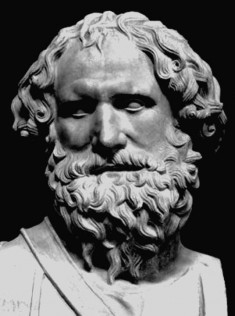| Archimedes | |
|---|---|
 |
|
| Mathematician | |
| Specialty | Math, physics, engineering, astronomy |
| Born | c. 287 BC Syracuse, Sicily Magna Graecia |
| Died | c. 212 BC (around age 75) Syracuse |
| Nationality | Greek |
Archimedes was born in 287 B.C. on the island of Sicily. His father, Phidias, was a mathematician and an astronomer. They lived in Syracuse when Archimedes was born.
General Biography
Little is known about Archimedes and his family in the early years. He studied in Alexandria, which had been established by Alexander the Great. This is where he grew to become a reputable scholar. He studied under Euclid, the most reputable mathematician of his time who was keen on matters relating to geometry. Archimedes died during the Second Punic war under the hands of General Marcus Claudius Marcellus after the city was captured following a two-year siege.
The Archimedes Screw
Upon returning to Syracuse, Archimedes became a close associate to King Hiero II. The invention of the Archimedes Screw resulted when the King needed to empty rainwater from a ship. When Archimedes was called to help, he made the machine that came to be known as the Archimedes Screw.
This consisted of a hollow tube that had a spiral that could be turned using a handle placed on one end. Through this machine, the King was able to empty water from the hull of one of his ships, an invention that is widely used for irrigation in different parts of the world today.
Block and Tackle Pulley
Archimedes also invented the block-and-tackle pulley that used the Leverage Principle. It enabled sailors of his time to lift objects that would ordinarily be too heavy for them to lift. He is famously known to have argued that it would be possible to move the earth if only you have somewhere else to stand.
The Archimedes Principle
Archimedes is widely credited for his invention on how to measure the volume of an irregular object. The invention came when Archimedes was asked to verify the purity of the gold crown that the King had made. King Hiero was suspicious that the crown was not of pure gold as he had desired but a mixture of gold and silver.
He made this discovery while he was in the bathtub – it was then that he realized that the volume of water displaced is equivalent to the volume of his body that was submerged. Through this, he was able to calculate the density of the crown since he calculated the volume based on the volume of displaced water.
The Claw of Archimedes
When Syracuse was under attack by the Romans, Archimedes was tasked with the responsibility of developing a method of protecting the city from attackers. He developed the crane-like arm that had a metallic hook suspended on it to capsize ships. When the claw was dropped, the arm moved forwards to lift the attacking ship out of the water. This device was famously known as the ship-shaker.
The Heat Ray
Archimedes invented the famous “Death Ray” during the war with the Romans. This invention involved focusing multiple mirrors toward the sun and having them reflect to the enemy ships. This would cause them to burst into flames. This invention has, however, faced criticism from different scholars that it would not be practically viable for such an invention to work.
Archimedes also assisted greatly in the first Punic War by helping improve the power and accuracy of catapults.
Contributions to Mathematics
 Archimedes invented his own numbering system to accommodate the numbers he invented as part of his studies. He developed a method of calculating the area of different geometric figures by dividing the component into multiple rectangles that would be added together, a principle that later came to be known as the Principle of Integration.
Archimedes invented his own numbering system to accommodate the numbers he invented as part of his studies. He developed a method of calculating the area of different geometric figures by dividing the component into multiple rectangles that would be added together, a principle that later came to be known as the Principle of Integration.
This is used in integral calculus. Archimedes also invented differential calculus, which he used to determine the slope of tangents of lines on the figures he drew. He is also the scientist who discovered a method of calculating square roots of odd numbers when he calculated the square root of three, a principle that is called the Quadrature of the Parabola.
Through this method, Archimedes was able to prove that the area under a parabola and a straight line is 4/3 times the area of a triangle that has a height that is equal to its base.
Archimedes’ favorite works were the mathematical illustrations that contain a sphere and a cylinder that have a height equal to the diameter. He discovered that the volume and the area of the sphere is 2/3 the surface area of the sphere. This invention was inscribed on Archimedes’ grave following his death at 75 years of age.